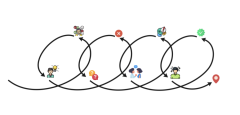Conclusion: this primary research made me realize that I need to specify my audience from fine art graduates to fine art graduates who want to be a freelancer or wear more than one hat. This process also helped me to enrich the definition of my model, for example, I put ‘the ability to be humble’ to the ‘self-control ability’. This also verifies the feasibility and credibility of the test I designed to a certain extent.


online talk with Yigao (fine art background, currently working in a film company ) 
offline talk with Chery (fine art backgroud, currently studying fine art PhD)
I talked with two stakeholders about my project and my career model as my primary research to acquire more opinions and fine art background students’ suggestions.
1. Talking with Yigao (fine art background, currently working in a film company)
Before talking to Yigao, I ask her to test the organisation’s ability, the sequencing question of intervention 6. Surprisingly, her answer was the closest to the correct answer. (Her answer is 5-2-4-1-3, and the correct answer is 2-5-4-1-3.) Then we talked about whether she is an organised person. Both she and I think she is a well-organised person, whether in life or study or work. So I guess, to some extent, this result shows the feasibility of this organization ability test.
After that, I introduced my career model, and we discussed her changes in these abilities before and after graduation. The conclusion is that, except for cooperating ability, the rest improved a lot after entering the workforce. Because when she works in a company, she has to undertake her tasks and responsibilities that she should complete. Every link has a corresponding person in charge, so there is no need to coordinate the process of cooperation. The whole collaboration is conducted under specific procedures.
I think it depends a lot on what she does and how the company works. For those fine art students who want to be freelancers, cooperation ability is vital since they need to actively seek cooperation to get more job opportunities. Then I realized that I needed to specify the audience of this career model. This model is more suitable for those who want to be freelancers/start their own business,/wish to do multiple jobs.
2. Talking with Chery (fine art background currently studying fine art PhD)
I was talking to Chery about his experience of selling paintings. He said that when he is doing his bachelors degree, he doesn’t like selling his work since he thinks art is the art that cannot be valued by money. In addition, his parents believe that it is tough for this subject to find a job(compared with design subjects and science and technology, finance etc.). So his father worried about it and tried to sell his paintings at that time. ‘I hated it,’ he says. ‘I didn’t want to sell my work, and I certainly didn’t want it to be bought by people who couldn’t read it. But I don’t think so anymore. You know, most of the fine art students are a bit self-glorification. Ummm, it’s a good thing to sell paintings, you know, I found that It’s even harder for me to sell paintings by myself without my father’s help, and I have to face reality, I want to earn money.’
Although it’s a single case, it can illustrate some phenomena. Self-glorification, too confident, could be the label of most fine art students. Going back to what I did in unit 2- help fine art student to sell their artworks through synaesthesia. After finding a relatively effective way to combine sound and paintings, I realized that it is hard to sell this idea to fine art students because of their personalities, their typical temperament. This point is also one of the main reasons for art students’ problematic employment. So I added the ability to be hambling in my model.
